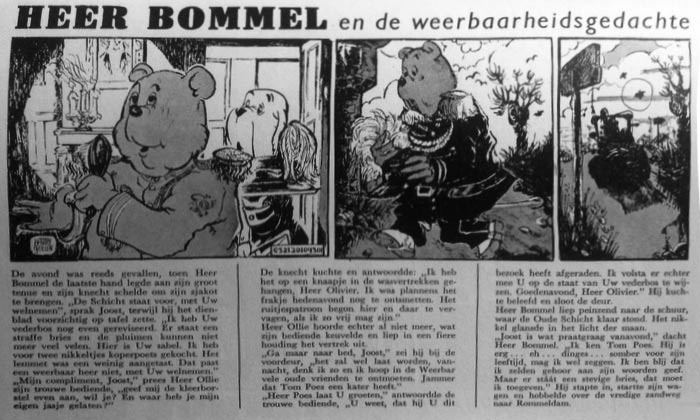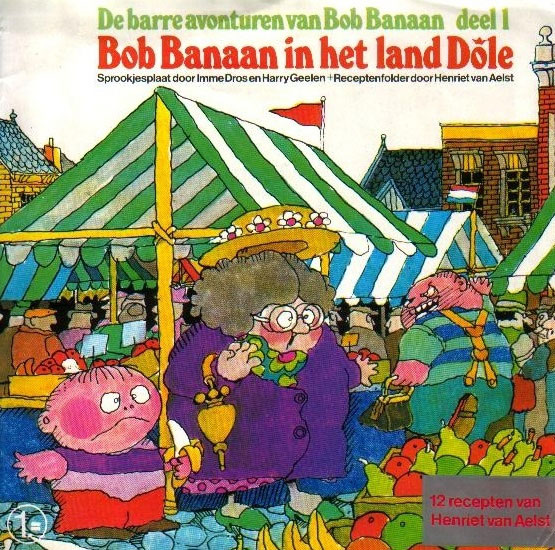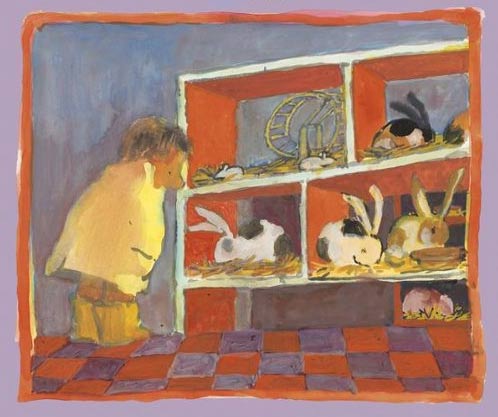'Het Allerliefste Wil Ik Een Racefiets (Jippo #11, 1977-1978).
Harrie Geelen had a long and versatile career in Dutch media. He was active as an animator, scriptwriter, illustrator, director, cartoonist, voice actor, songwriter and translator. During his long-term affiliation with the Marten Toonder Studios, Geelen worked for both the comic and the animation division. He is best-known for creating some of the most legendary Dutch children's TV shows of the 1970s, such as 'Oebele' (1968-1972), 'Kunt U Mij De Weg Naar Hamelen Vertellen, Mijnheer?' (1972-1976) and 'Q & Q' (1974-1976). As an illustrator, Geelen provided the illustrations for many children's books written by his wife Imme Dros, while he has also created some books of his own. Generations of Dutch children have grown up with Geelen's writings, making him one of the most important contributors to Dutch cultural legacy.
Cover illustration by Harrie Geelen.
Early life and career
Harrie Geelen was born in 1939 in Heerlen, a city in the Dutch southern province of Limburg. Raised into an artistic Catholic family, his father was an avid storyteller, while his mother came from a famous family of copper plate engravers. His sister Roos Geelen became an artist, and introduced him to the painters and sculptors of the Maastricht Academy. When his sister settled in Amsterdam with her husband, actor/director André van den Heuvel, Harrie Geelen joined them in 1958 to study Dutch Language and Literature. He also joined the Amsterdam Student's Union and was co-initiator of the cabaret group Sing-Sing. In addition, Geelen served as the editor and illustrator of the student's almanac, as well as the programs of the cabaret performances. Later in life he worked as a teacher in animation and scriptwriting at the Rietveld Art Academy in Amsterdam.
Children's books
In the late 1950s, Harrie Geelen met the future children's novelist Imme Dros, whom he married in 1963. Geelen became the main illustrator of her stories, which were published in magazines and books, mostly by publisher Querido. Their first joint production 'Het paard Rudolf' (1971) was followed by a great many more collaborations, most notably 'Ik Wil Die!' (1991), 'Morgen ga ik naar China' (1995), 'Griekse Mythen' (2004), 'Bijna Jarig' (2005) and 'Het Boeboek' (2010). The children's books by Dros and Geelen have been translated into French, Danish, Swedish and Japanese.
Tom Poes parody
In 1961, Geelen first went to the Marten Toonder Studios in Amsterdam to ask permission for making a parody of Toonder's 'Tom Poes', which he wanted to write and draw himself. The spoof, titled 'Heer Bommel en de Weerbaarheidsgedachte', was part of 'Weerbaar en Student', a commemorative book about student's fighting units during World War I and II and was made entirely in the style of a typical 'Tom Poes' text comic, including Toonder's actual characters. During his visit, Geelen didn't meet Toonder in person, but was informed that he, reluctantly, agreed to the publication. It took a while before the young writer/artist returned to the Toonder Studios.
Early TV career
In late 1962, Geelen broke off his studies and went to work as a copywriter for the Prad advertising agency. After a short while, he was hired as storyboard artist and gag man with Joop Geesink's production company Dollywood. Around the same time, Geelen also had his first ventures as a TV scriptwriter, when the broadcasting corporation VARA hired him to write songs for a special TV show with the young singer Rob de Nijs (1964-1966). He also wrote scripts for the youth TV show 'Fanclub' (1965-1968), and the scripts and songs for the award-winning children's musicals 'Bah September' (1966) and 'Leve Juffrouw Cannebier' (1968).
'Heer Bommel en de Weerbaarheidsgedachte', Harrie Geelen's 1961 Tom Puss parody.
Toonder Studios
Thanks to comic scriptwriter Andries Brandt, Geelen became an employee of the Toonder Studios. Starting in 1967, he worked there until the early 2000s, albeit with intervals. By then, Marten Toonder himself had already moved to Ireland, and his studio was relocated to the castle of Nederhorst den Berg, The Netherlands. Geelen's first assignment was writing scripts for the weekly 'Tom Poes' comics in Donald Duck magazine. While the newspaper version of 'Tom Poes' was a text comic, with captions underneath the images, the 'Tom Poes' stories in Donald Duck had speech balloons. One of the identified Geelen-scripted stories was 'Tom Poes en de Paspoort' (1967), drawn by Wim Lensen.
However, his main occupation throughout the decades were the studio's film productions. Eventually appointed as "creative director", Geelen was involved in the writing, directing, storyboards, special effects and sound for many of the studio's animation, live action and puppet productions. Geelen was also the scriptwriter of 'Als Je Begrijpt Wat Ik Bedoel' (1983), the feature-length movie starring Marten Toonder's signature creations Tom Poes (Tom Puss) and Olivier B. Bommel (Lord Bumble), produced by Rob Houwer. Along with Björn Frank Jensen and Bert Kroon, Geelen also served as co-director of the production, while he also wrote the songs and provided the voice for the Wammes Waggel character. Geelen's more personal animated film 'Getekende Mensen' (1984), about heroin users, received the Dutch film prize Gouden Kalf (1985) and the Joop Geesink Prize for Applied Animation during the Holland Animation Filmfestival (1985).
De Sommels van de Sommelsberg, by Imme Dros and Harrie Geelen (Jippo #18, 1977-1978)
Later TV career
In the late 1960s, Geelen began working extensively for the Dutch broadcasting company KRO. Most of the productions with his participation were children's TV series with a soundtrack by Joop Stokkermans. The first of his hit series was 'Oebele' (31 episodes, 1968-1972), about a group of children from the fictitious county of Oebele aan de Oe. The main actors were Wieteke van Dort and Willem Nijholt. The follow-up series was 'Kunt U Mij De Weg Naar Hamelen Vertellen, Mijnheer?' (45 episodes, 1972-1976), which was loosely based on the fairy tale 'The Pied Piper of Hamelin' and starred Rob de Nijs, Loeki Knol, Martin Brozius and others. The adventure series 'Q & Q' (26 episodes, 1974-1976) became one of the most-watched Dutch children's series of all time, with an average of 3.1 million viewers. Geelen's programs for KRO television were groundbreaking because children filled a large part of the cast; in the case of 'Q & Q' even the two main actors were children.
Geelen also wrote the songs for the children's comedy TV show 'Peppi en Kokki' (1972-1978), and was a translator and voice actor for the American sections of the Dutch 'Sesame Street' (based on Jim Henson's creations). Geelen additionally produced a partially animated and partially live action TV adaptation of 'De Avonturen van Meneer Prikkebeen' (1972), based on the 1845 comic strip 'M. Cryptogame' by the Swiss artist Rodolphe Töpffer. Geelen's further TV work included the children's TV movie 'Een Meester Minder' (1974) and a TV series about the popgroup Dolly Dots (1983).
'Bob Banaan'.
Film and theatrical career
In 1978, Geelen wrote and directed a feature film based on the 'Pinkeltje' books by Dick Laan (which were illustrated by Rein van Looy). He also translated many new and re-released Disney films into Dutch, including 'The Aristocats', 'The Great Mouse Detective', 'Snow White and the Seven Dwarfs', 'Robin Hood', 'Peter Pan' and 'One Hundred and One Dalmatians'. Geelen additionally became a productive scriptwriter for theatrical productions, most notably for Frank Groothof's solo shows based on famous operas. Songs written by Geelen have been performed by Boudewijn de Groot, Liesbeth List, Leen Jongewaard, Lex Goudsmit, Adèle Bloemendaal, Herman van Veen and André van den Heuvel. One of his most remarkable co-productions with Imme Dros was 'Bob Banaan in het land Dôle' (1976), a musical children's story promoting the consumption of Dole bananas.
'Het Beertje Pippeloentje', illustrations by Harrie Geelen.
Children's comics and illustrations
In addition, Geelen wroten and drew several children's comics and stories, among them 'Gracchus' (published in KRO-gids, 1969) and 'Job en Juultje' (Krantje 3). For the Groningen University Paper, he made a rare adult comic, 'Strib'. Since 1971, he is best known as the illustrator for most of the books by his wife Imme Dros. The couple has also collaborated on short stories and comics for the magazine Jippo, published by Malmberg. In 2004, Geelen produced a movie based on his wife's children's book 'Annetje Lie in het Holst van de Nacht' (1987) for VPRO television. The picture was partially live-action, partially animation.
Geelen also livened up the pages of children's books by Dolf Verroen ('Zo Sterk Als Een Leeuw', 1990), Toon Tellegen ('Juffrouw Kachel', 1991), Paul Biegel ('Een Huis Vol Beren', 1993), Annie M.G. Schmidt ('Het Beertje Pippeloentje' [1994] and 'Beestenboel' [1995]) and Hans Hagens ('Stilte A.u.b. Ik Denk Aan De Kip', 1995). He has also written and illustrated his own children's books, for instance 'Koning Boon' (1984), 'Toen Sjoerd Naar De Dierentuin Ging' (1992), 'Herman Het Kind en de Dingen' (1993) and 'Het Boek van Jan' (2000).
'Pissebed Fred' by Imme Dros, with illustrations by Harrie Geelen.
Return to Toonder Studios
In 1987-1988, Geelen returned to comic strips and the Toonder Studio's, succeeding Eiso Toonder as the scriptwriter of Toonder's newspaper comic 'Panda'. Since main artist Piet Wijn had left the comic a couple of years earlier, the artwork during Geelen's period was handled by Toonder staff artists Frits Godhelp and Jaap Lamberton. He wrote up to five 'Panda' stories. Geelen's later work for the Toonder Studio's included the TV movie 'Carmen & Ik' (1991), starring Frank Groothof and Porgy Franssen, and the animated series 'De Sommeltjes' (2003). Geelen was forced to retire from the Toonder Studios when the company closed down his one-man division.
Recognition
Geelen's film 'Getekende Mensen' (1984) won the Gouden Kalf (1985) and Joop Geesink Prize for Applied Arts (1985). As a children's book illustrator, he received the Gouden Potlood ("Golden Pencil") twice, in 1991 and 1994, for respectively 'Juffrouw Kachel' and Het Beertje Pippeloentje'. On 9 November 2014, Harrie Geelen was named Knight in the Order of the Dutch Lion. In 2001, an overview of Geelen and Imme Dros' work was held in the Literary Museum in The Hague.
Final years and death
Later in life, Harrie Geelen came to notice as a translator, for instance translating from Latin the Ovid books 'Metamorphoses' (2022) and 'Heroides' (2024). In 2025, the final co-production of Harrie Geelen and his wife Imme Dros was published by Querido, the children's book 'Reinier'. His final project was a new translation with 60 illustrations of the classic Middle Dutch story 'Van den Vos Reynaerde', under the title 'De zaak Reinaerd Vos' (In de Knipscheer, 2025). Harrie Geelen died on 30 August 2025, two weeks before the book's release, at the age of 86. Geelen's son Pieter Geelen is co-founder of the TomTom NV navigation company.










